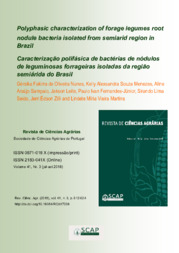Polyphasic characterization of forage legumes root nodule bacteria isolated from semiarid region in Brazil.
Polyphasic characterization of forage legumes root nodule bacteria isolated from semiarid region in Brazil.
Autoria: NUNES, G. F. de O.; MENEZES, K. A. S.; SAMPAIO, A. A.; LEITE, J.; FERNANDES JUNIOR, P. I.; SEIDO, S. L.; ZILLI, J. E.; MARTINS, L. M. V.
Resumo: Forage legumes are important resources in semiarid regions due to their abilities to adapt to soils with low fertility and fix nitrogen when associated with diazotrophic bacteria. Here, we applied a polyphasic approach to characterize a set of legume nodule isolates obtained from Clitoria ternatea and Stylosllntlzes capitata cultivated in the soils of a semiarid region of Brazil. A tolal of 126 bacterial isolates were obtained: 45 isolates frorn C. ternatea and 81 isolates from S. capitata. Nodulation tests revealed only ten isolates that nodulated their original host: six isolates from C. iernaiea and four isolates from S. capitata. These ten legume nodule isolates were phenotypically and genotypically characterized. All isolates grew in fructose, glucose, sodium glutamate, maltose, xylose. and sucrose. Metabolic tests showed a relationship between tolerance to salt and high temperaturas, where isolates that tolerated the highest salt concentration also tolerated the highest ternperature. Three isolates showed amylolytic activity, and four isolates showed carboxymethyl cellulolytic activity. 5treptomycin was the most limiting and nalidixic acid was the least limiting antibiotic to bacterial growth. Seven out of ten isolates were indol-acetic acid producers. Additionally, 165 rRNA gene partial sequencing enabled the identification of members of the genera Bacillus (1), Bradvrhizobium (4), Leifeonia (3), Microvirga (1), and Rhizobium (1). These data reveal phenotypically and genotypically di verse bacteria inhabiting the nodules of the forage legumes C. tematea and S. capitata represent an important microbial source to protect new biotechnological products and improve forage legumes in semiarid regions.
Ano de publicação: 2018
Tipo de publicação: Separatas
Unidade: Embrapa Agrobiologia
Observações
1 - Por padrão são exibidas publicações dos últimos 20 anos. Para encontrar publicações mais antigas, configure o filtro ano de publicação, colocando o ano a partir do qual você deseja encontrar publicações. O filtro está na coluna da esquerda na busca acima.
2 - Para ler algumas publicações da Embrapa (apenas as que estão em formato ePub), é necessário ter, no celular ou computador, um desses softwares gratuitos. Sistemas Android: Google Play Livros; IOS: iBooks; Windows e Linux: software Calibre.
Acesse outras publicações
Acesse a Base de Dados da Pesquisa Agropecuária (BDPA) para consultar o acervo completo das bibliotecas da Embrapa.

